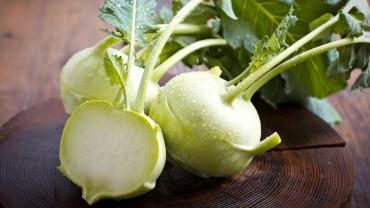
As the season of farmer’s markets tailgate markets and neighborhood gardens are in full swing the large variety of produce delightfully tempts creative consumers to stray from their usual fare. Others confidently stick with familiar items and scarcely even glance at the unusual shapes and colors sported by some of the more uncommon species of vegetables. However these unconventional vegetables are often packed full of health-promoting nutrients that compliment that more conventional choices.
Endeavoring to try different selections of fruits and vegetables not only increases the variety of flavors and textures in the diet but also improves the daily nutrient panel. Far too many consumers limit their dietary choices leaving gaps in their nutrition.
Okra
Also known as “lady fingers” this member of the mallow family is versatile and nutritious. The unique mucilaginous character of okra has deterred some consumers from making it a routine food choice. When cooked the seed pods produce a gelatinous substance due to the high concentration of pectin a soluble fiber. This fiber makes okra an impressive food for regulating blood sugar promoting detoxification managing appetite and supporting weight loss.
Okra is rich in antioxidants and has been found to be beneficial in numerous health conditions associated with oxidative stress. One study found okra to be protective against oxidative stress-mediated complications associated with diabetes. In a similar study investigating the effects of okra on cellular oxidative stress in Alzheimer’s and neurodegenerative diseases cells treated with okra showed significantly decreased reactive oxygen species (ROS) hydrogen peroxide (H2O2) and protein oxidation compared to untreated cells. In addition lectin isolated from okra has anti-tumor effects including significantly reducing cell growth and inducing apoptosis.
Bok Choy and Kohlrabi
Bok Choy is a familiar constituent of Chinese cuisine often identified as a type of cabbage making it a member of the renowned group of cruciferous vegetables. Like bok choy kohlrabi also resides among the cruciferous vegetables but makes its roots in German cuisine being known as a German turnip. Both bok choy and kohlrabi possess the disease-fighting phytonutrients isothiocyanates sulforaphane and indole-3-carbinol. These compounds have been studied extensively for their cancer-fighting actions including antioxidant action detoxifying enzymes inducing apoptosis and cell cycle regulation. Indole-3-carbinol has shown tremendous protective action against prostate colon and breast cancer by reducing cancer cell growth; however it also suppresses propagation of cancer cells of the colon bladder and pancreas.
Bok choy and kohlrabi also share health-promoting anthocyanins. Found in the purple leaves of specific varieties of bok choy and the purple body of kohlrabi anthocyanins are a unique subset of flavonoids. Studies have found that anthocyanins are able to be absorbed through both the stomach and intestinal wall after which they are metabolized and enter systemic circulation as highly active metabolites including phenolic acids. Anthocyanin metabolites contribute to the reduction of cardiovascular disease and cancer. They also modulate inflammatory pathways and may act as a prebiotic agent positively modulating the gut microbiota with favorable health benefits.
Jerusalem Artichoke
Not to be confused with the green flower-like artichokes of the thistle family a Jerusalem artichoke is actually a tuber from the daisy family. This long horny tuber may look like a potato but surprisingly does not have a high starch content. Instead it is best known for its dietary fiber and fructan content which may prove to be beneficial for diabetes. Fructan from Jerusalem artichokes has been studied and found to reduce fasting plasma glucose levels. Fructan inhibits α-glucosidase an intestinal enzyme involved in digesting carbohydrates. α-Glucosidase inhibitors such as fructan delay carbohydrate absorption improving postprandial glucose levels. A recent animal study showed dried Jerusalem artichoke “increased caecal valeric acid level decreased the concentration of isoacids in the colon reduced β-glucosidase and β-glucuronidase activity in the middle colon and increased Bifidobacterium spp. populations in the proximal and distal colon” prompting interest in the ability of this tuber to positively modulate gut microbiota and health.
The battle to increase consumption of fruits and vegetables remains; yet some studies suggest that variety of fruits and vegetables may impart more health benefits than mere quantity. Therefore encouraging patients to expand their palates and try new vegetables is equally important in promoting a path towards optimal health.